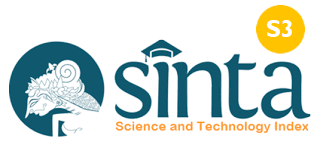Penerapan Metode Bercerita dan Bernyanyi Untuk Meningkatkan Hasil Belajar Agama Hindu Siswa Kelas III Semester I SD Negeri 1 Dukuh
Keywords:
Storytelling and Singing Methods, Learning Outcomes.Abstract
The purpose of this study was to improve student learning outcomes in the subjects of Hindu Religion Class III SD Negeri 1 Dukuh through the application of singing and storytelling methods in learning Hindu Religious Education. This classroom action research was carried out in two cycles. The subjects of this study were the third grade students of SD Negeri 1 Dukuh, totaling 16 people consisting of 8 female students and 8 male students. Data were collected by observation and learning outcomes tests. The collected data was then analyzed by qualitative descriptive statistics. The results showed that the application of storytelling and singing methods could improve student learning outcomes. This can be seen from the average learning outcomes, absorption and classical mastery of students in cycle I to cycle II which increased. The average value of the first cycle reached 76.25 and the second cycle reached 82.50. That means, the average value from cycle I to cycle II has increased by 6.25. Likewise for student absorption. Classical completeness of students in the first cycle was 68.75% with 11 students completed and 5 students incomplete. Furthermore, in the second cycle of classical completeness 100% with 16 students completed. Based on these data, students' classical mastery between cycle I and cycle II increased by 31.25%. Based on these results, several suggestions can be recommended, namely: Hindu Religious Education teachers are expected to apply storytelling and singing methods to improve student learning outcomes. students.
References
Andyka Putra Gotama, P. (2012). Strategi Pembelajaran. Amlapura: STKIP Agama Hindu Amlapura.
Arikunto, S. (1998). Dasar-Dasar Evaluasi Pendidikan. Jakarta: Bumi Aksara
Arikunto, S. (2006). Prosedur Penelitian: Suatu Pendekatan Praktik. Jakarta: Rineka Cipta.
Bachir, S B. (2005). Pengembangan Kegiatan Bercerita, Teknik, dan Prosedurnya. Jakarta : Depdikbud
Buda Praksita Sri Pandita. (1986). Grahasta Winaya. Singaraja.
Bloom. (2008). Taksonomi Hasil belajar. Evaluasi Pendidikan. Surabaya: Usaha Nasional
Darsono dkk. (2000). Belajar dan pembelajaran. Semarang : MKK Unnes.
Gagne Elaine. (2009). Contextual Teaching & Learning. Bandung: Mizan Learning Center
Hermawan. (2006). Menjadi Guru yang Kreatif. Jakarta : PT Pustaka Jaya
Musfiroh, T. (2005). Bercerita Untuk Anak Usia Dini. Jakarta : Depdikbud
Sujana. (1989). Jenis jenis Metode Pembelajaran. Jakarta: PT. Bineka Cipta
Sujana. (1997). Belajar dan Faktor-Faktor yang Mempengaruhinya. Jakarta: PT. Bineka Cipta
Sulistiyo. (2007). Pembelajaran yang Aktif dan Menyenangkan. Semarang : PT Sukses Abadi
Poerwanto, N. (1987). Pengertian Prestasi Belajar. Tersedia pada: http ://sunartombs.wordpress.com/2009/01/05/Pengertian-Frestasi-Belajar/.
Suryabrata, 1997 Tersedia dalam http://www.google.com.Intelegensi VS Prestasi
Tim Penyusun. (1999). Kamus Besar Bahasa Indonesia. Jakarta : Balai Pustaka
Tirta. (1990). Guru dalam Pembelajaran. Surabaya : PT Cahaya Gemilang
Tim. (1999). seminar kesatuan tafsir terhadap aspek-aspek Agama Hindu I – XV . Denpasar
UU Nomor 20 tahun 2003 tentang Sisdiknas
Parisada Hindu Dharma Indonesia Pusat. (1993). Darma Upadesa. Denpasar
Peraturan Menteri Pendidikan Nasional Republik Indonesia nomor 22 tahun 2006 tentang Standar Isi untuk Satuan Pendidikan Dasar dan Menengah
Wiana, K. (1993). Pendidikan Agama Hindu untuk SMA. Jakarta : Tiga Serangkai.
Wiana, K. (1997). Buku Ajar Perkuliahan Pelaksanaan Pengajaran. Jakarta : Tiga Serangkai
Wardani. (2003). Materi Pokok Penelitian Tindakan Kelas. Jakarta: Pusat Penerbitan Universitas Terbuka
Downloads
Published
How to Cite
Issue
Section
License
An author who publishes in the Cetta : Jurnal Ilmu Pendidikan agrees to the following terms:
- Author retains the copyright and grants the journal the right of first publication of the work simultaneously licensed under the Creative Commons Attribution-ShareAlike 4.0 License that allows others to share the work with an acknowledgement of the work's authorship and initial publication in this journal
- Author is able to enter into separate, additional contractual arrangements for the non-exclusive distribution of the journal's published version of the work (e.g., post it to an institutional repository or publish it in a book) with the acknowledgement of its initial publication in this journal.
- Author is permitted and encouraged to post his/her work online (e.g., in institutional repositories or on their website) prior to and during the submission process, as it can lead to productive exchanges, as well as earlier and greater citation of the published work (See The Effect of Open Access).
Read more about the Creative Commons Attribution-ShareAlike 4.0 Licence here: https://creativecommons.org/licenses/by-sa/4.0/.





